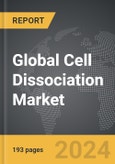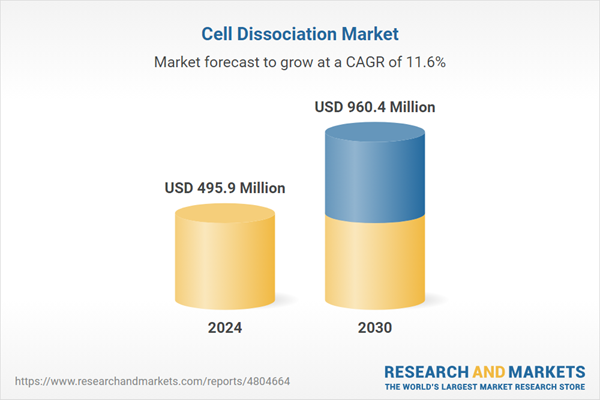The global market for Cell Dissociation was valued at US$495.9 Million in 2024 and is projected to reach US$960.4 Million by 2030, growing at a CAGR of 11.6% from 2024 to 2030. This comprehensive report provides an in-depth analysis of market trends, drivers, and forecasts, helping you make informed business decisions. The report includes the most recent global tariff developments and how they impact the Cell Dissociation market.
Segments: Product Type (Enzymatic Dissociation Products, Non-Enzymatic Dissociation Products, Instruments & Accessories); Tissue (Connective Tissue, Epithelial Tissue, Other Tissues); End-Use (Pharma & Biotech Companies, Research & Academic Institutes, Other End-Uses).
Geographic Regions/Countries: World; United States; Canada; Japan; China; Europe (France; Germany; Italy; United Kingdom; and Rest of Europe); Asia-Pacific; Rest of World.
The analysts continuously track trade developments worldwide, drawing insights from leading global economists and over 200 industry and policy institutions, including think tanks, trade organizations, and national economic advisory bodies. This intelligence is integrated into forecasting models to provide timely, data-driven analysis of emerging risks and opportunities.
Global Cell Dissociation Market - Key Trends and Drivers Summarized
How Is Cell Dissociation Shaping Modern Biomedical Research?
Cell dissociation is a critical process in biomedical research and therapeutic development, enabling researchers to separate adherent cells from their culture environment or dissociate tissues into single cells. This technique is essential for various applications, including cell culture, stem cell research, flow cytometry, and single-cell sequencing. By using enzymes such as trypsin, collagenase, or non-enzymatic solutions, scientists can gently release cells from their substrates without compromising cell viability or function. The ability to obtain viable, functional cells is paramount for studies that involve subsequent culturing, cell-based assays, or cellular reprogramming. Cell dissociation is widely used in cancer research, where tumor tissues must be dissociated into individual cells for molecular analysis or drug screening. It is also crucial in tissue engineering and regenerative medicine, where the isolation of specific cell types is required for developing scaffolds and artificial tissues. With advancements in techniques and reagents, cell dissociation has become more efficient, enabling researchers to achieve higher yields of viable cells while minimizing cell damage. The significance of this process extends across a broad range of biological research fields, making it a fundamental tool in both basic science and applied medical research.Why Is Cell Dissociation Essential for Single-Cell Analysis and Therapeutics?
Cell dissociation plays a pivotal role in single-cell analysis, a rapidly growing field in biomedical research that seeks to understand cellular heterogeneity within tissues. Single-cell technologies, such as RNA sequencing and proteomics, require the dissociation of tissues into individual cells to analyze the genetic and phenotypic diversity of cells in a given population. This is particularly important in cancer research, where understanding tumor heterogeneity can reveal critical insights into disease progression and treatment resistance. In immunology, cell dissociation enables the isolation of specific immune cell populations for in-depth functional studies and drug testing. Furthermore, in the development of cell-based therapeutics, including CAR-T cell therapy and stem cell transplants, the dissociation process ensures that enough viable cells are obtained from tissue biopsies or culture systems for therapeutic use. Ensuring that dissociation protocols preserve cell functionality is essential, as any damage to cell membranes or receptors during the process could affect downstream analysis or therapeutic efficacy. As the field of single-cell biology continues to expand, the demand for optimized cell dissociation techniques will only increase, emphasizing the importance of precise and gentle dissociation methods to preserve cell integrity.How Are Technological Advancements Enhancing the Efficiency of Cell Dissociation?
Technological advancements have significantly improved the efficiency and reliability of cell dissociation methods, driving innovation in both research and clinical applications. New enzymatic formulations and reagents have been developed to minimize the time required for cell detachment while maximizing cell viability. For example, some of the newer enzyme blends can dissociate more resistant tissues, such as fibrotic or heavily collagenous samples, more effectively than traditional methods like trypsinization. In addition to enzymes, non-enzymatic solutions have gained traction for their ability to dissociate cells with reduced impact on surface proteins, making them ideal for sensitive applications like flow cytometry and receptor analysis. Automation and high-throughput systems have also enhanced cell dissociation, allowing laboratories to process multiple samples simultaneously and with greater precision. Microfluidics and mechanical dissociation devices provide alternative methods to enzymatic approaches, reducing the risk of enzyme-induced damage and enabling the dissociation of more complex tissues, such as brain or liver samples. These innovations not only improve the quality and quantity of dissociated cells but also expand the range of tissues and applications that can be effectively studied, pushing the boundaries of cell-based research and clinical therapeutics.What Is Driving the Growth in the Cell Dissociation Market?
The growth in the cell dissociation market is driven by several factors, including advancements in biotechnology, the rise of personalized medicine, and increasing demand for cell-based therapies. One of the key drivers is the growing need for high-quality single cells in drug discovery and development. Pharmaceutical companies and research institutions rely on dissociated cells to screen for new drugs, particularly in areas like oncology and immunotherapy. The expansion of stem cell research, especially in regenerative medicine, is also fueling demand for optimized cell dissociation techniques that can preserve stem cell viability and differentiation potential. Technological advancements, such as the development of more efficient enzymatic and non-enzymatic dissociation reagents, are driving adoption in laboratories and clinics, making the process more reliable and scalable. The shift toward single-cell analysis in genomics and proteomics is another major factor, as dissociation is a critical step in isolating individual cells for detailed molecular studies. Consumer behavior in the form of increased healthcare spending, along with the rising prevalence of chronic diseases and cancer, is further propelling market growth. Additionally, the increasing use of cell dissociation in emerging applications such as 3D bioprinting and tissue engineering presents new opportunities for market expansion, as these fields require precise control over cell populations for the creation of complex tissue structures. Together, these trends are expected to sustain the rapid growth of the cell dissociation market in the coming years.Report Scope
The report analyzes the Cell Dissociation market, presented in terms of units. The analysis covers the key segments and geographic regions outlined below.Segments: Product Type (Enzymatic Dissociation Products, Non-Enzymatic Dissociation Products, Instruments & Accessories); Tissue (Connective Tissue, Epithelial Tissue, Other Tissues); End-Use (Pharma & Biotech Companies, Research & Academic Institutes, Other End-Uses).
Geographic Regions/Countries: World; United States; Canada; Japan; China; Europe (France; Germany; Italy; United Kingdom; and Rest of Europe); Asia-Pacific; Rest of World.
Key Insights:
- Market Growth: Understand the significant growth trajectory of the Enzymatic Dissociation Products segment, which is expected to reach US$506.9 Million by 2030 with a CAGR of a 12.6%. The Non-enzymatic Dissociation Products segment is also set to grow at 11.1% CAGR over the analysis period.
- Regional Analysis: Gain insights into the U.S. market, valued at $136.7 Million in 2024, and China, forecasted to grow at an impressive 11.1% CAGR to reach $148.7 Million by 2030. Discover growth trends in other key regions, including Japan, Canada, Germany, and the Asia-Pacific.
Why You Should Buy This Report:
- Detailed Market Analysis: Access a thorough analysis of the Global Cell Dissociation Market, covering all major geographic regions and market segments.
- Competitive Insights: Get an overview of the competitive landscape, including the market presence of major players across different geographies.
- Future Trends and Drivers: Understand the key trends and drivers shaping the future of the Global Cell Dissociation Market.
- Actionable Insights: Benefit from actionable insights that can help you identify new revenue opportunities and make strategic business decisions.
Key Questions Answered:
- How is the Global Cell Dissociation Market expected to evolve by 2030?
- What are the main drivers and restraints affecting the market?
- Which market segments will grow the most over the forecast period?
- How will market shares for different regions and segments change by 2030?
- Who are the leading players in the market, and what are their prospects?
Report Features:
- Comprehensive Market Data: Independent analysis of annual sales and market forecasts in US$ Million from 2024 to 2030.
- In-Depth Regional Analysis: Detailed insights into key markets, including the U.S., China, Japan, Canada, Europe, Asia-Pacific, Latin America, Middle East, and Africa.
- Company Profiles: Coverage of players such as American Type Culture Collection (ATCC), Becton, Dickinson & Company, F. Hoffmann-La Roche AG, GE Healthcare, HiMedia Laboratories and more.
- Complimentary Updates: Receive free report updates for one year to keep you informed of the latest market developments.
Some of the 44 companies featured in this Cell Dissociation market report include:
- American Type Culture Collection (ATCC)
- Becton, Dickinson & Company
- F. Hoffmann-La Roche AG
- GE Healthcare
- HiMedia Laboratories
- Merck KgaA
- Miltenyi Biotec GmbH
- PAN-Biotech GmbH
- StemCell Technologies Inc.
- Thermo Fisher Scientific, Inc.
Tariff Impact Analysis: Key Insights for 2025
Global tariff negotiations across 180+ countries are reshaping supply chains, costs, and competitiveness. This report reflects the latest developments as of April 2025 and incorporates forward-looking insights into the market outlook.The analysts continuously track trade developments worldwide, drawing insights from leading global economists and over 200 industry and policy institutions, including think tanks, trade organizations, and national economic advisory bodies. This intelligence is integrated into forecasting models to provide timely, data-driven analysis of emerging risks and opportunities.
What’s Included in This Edition:
- Tariff-adjusted market forecasts by region and segment
- Analysis of cost and supply chain implications by sourcing and trade exposure
- Strategic insights into geographic shifts
Buyers receive a free July 2025 update with:
- Finalized tariff impacts and new trade agreement effects
- Updated projections reflecting global sourcing and cost shifts
- Expanded country-specific coverage across the industry
Table of Contents
I. METHODOLOGYII. EXECUTIVE SUMMARY2. FOCUS ON SELECT PLAYERSIII. MARKET ANALYSISIV. COMPETITION
1. MARKET OVERVIEW
3. MARKET TRENDS & DRIVERS
4. GLOBAL MARKET PERSPECTIVE
UNITED STATES
CANADA
JAPAN
CHINA
EUROPE
FRANCE
GERMANY
ITALY
UNITED KINGDOM
REST OF EUROPE
ASIA-PACIFIC
REST OF WORLD
Companies Mentioned (Partial List)
A selection of companies mentioned in this report includes, but is not limited to:
- American Type Culture Collection (ATCC)
- Becton, Dickinson & Company
- F. Hoffmann-La Roche AG
- GE Healthcare
- HiMedia Laboratories
- Merck KgaA
- Miltenyi Biotec GmbH
- PAN-Biotech GmbH
- StemCell Technologies Inc.
- Thermo Fisher Scientific, Inc.
Table Information
| Report Attribute | Details |
|---|---|
| No. of Pages | 193 |
| Published | April 2025 |
| Forecast Period | 2024 - 2030 |
| Estimated Market Value ( USD | $ 495.9 Million |
| Forecasted Market Value ( USD | $ 960.4 Million |
| Compound Annual Growth Rate | 11.6% |
| Regions Covered | Global |









